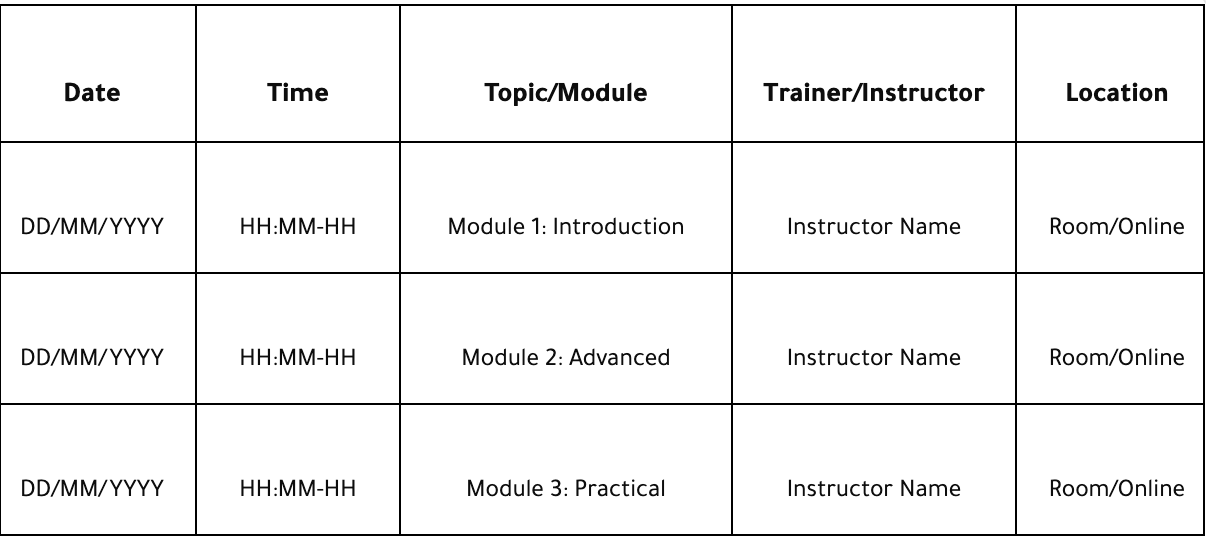How to Create a Successful Training Plan Using Salalem's Training Plan Template
Introduction
This comprehensive guide will assist you in creating effective training plans that meet your organization’s needs. Follow each section carefully to ensure a thorough and professional training plan. Continuous training is key to success and sustainable development in today’s business world. In this article, we will explore the essential steps to create an effective training plan using Salalem’s template to ensure the improvement of employee skills and enhance organizational performance.
1. Training Plan Overview
Purpose
The first step in building a successful training plan is defining its purpose. These goals should be clear and specific to direct training efforts towards achieving tangible results. For example, the purpose of a training plan may be to improve customer service representatives’ communication skills to increase customer satisfaction and reduce problem-solving time. The purpose of the training sets the direction and helps allocate resources effectively to achieve the desired goals.
Objective
The next step is setting specific, measurable objectives. Using SMART goals (Specific, Measurable, Achievable, Relevant, and Time-bound) ensures that the objectives are clear and achievable within a specified timeframe. For example, an objective might be:
"Improve customer service skills, including active listening, problem-solving, and conflict resolution, resulting in a 20% increase in customer satisfaction within six months."
Duration
Clearly define the total duration of the training program, including start and end dates. The duration should be sufficient to achieve the desired goals. For example:
"The training program will last for three months, from July 1st to September 30th."
Target Audience
Specifically identify the employees or departments that will participate in the training. Understanding the levels of knowledge and experience among the participants ensures that the training content is relevant and beneficial. For example:
"Customer service representatives in a specific region or country."
2. Assessing Training Needs
Skill Gap Analysis
Conducting a skill gap analysis helps identify the competencies that employees need to develop. Data-driven methods such as performance reviews and pre- and post-assessments can be used to identify these gaps. For example:
"An internal survey identified that 60% of customer service representatives struggle with handling difficult customers and resolving complex issues."
Performance Gaps
Highlight areas where employee performance does not meet organizational expectations. Use both quantitative and qualitative data to support these gaps. For example:
"Performance reviews indicated that average call resolution times exceed the company’s targets by 30%, impacting overall customer satisfaction."
Employee Feedback
Summarize feedback from employees regarding their training needs and preferences. Surveys or focus groups can be conducted to gather this information. For example:
"Employees expressed the need for more practical training scenarios and role-playing exercises to better handle real-world situations."
3. Training Objectives
Short-term Goals
Setting specific short-term goals helps motivate employees and track progress. For example:
- Reduce average call resolution times by 10% in the first month.
- Improve customer satisfaction ratings by 15% within three months.
- Train 100% of customer service representatives on advanced communication techniques by the end of the program.
Long-term Goals
Long-term goals focus on continuous improvement and skill development over an extended period. For example:
- Achieve a 25% reduction in customer complaints within the next year.
- Develop a sustainable training program for continuous skill improvement.
- Increase employee retention in the customer service department by 20% over the next two years.
4. Training Methods
Practical Training
Describe how hands-on training will be conducted, including mentoring and follow-up opportunities. For example:
"Customer service representatives participate in follow-up sessions with experienced colleagues and receive immediate feedback during real customer service calls."
Classroom Training
Detail classroom training sessions, specifying topics, trainers, and schedules. Use interactive methods such as case studies and role-playing exercises. For example:
"Weekly classroom sessions cover key topics like active listening, empathy, and conflict resolution. Sessions will be interactive, with case studies and group discussions."
E-Learning
Provide details about online courses and e-learning modules. Highlight any Learning Management Systems (LMS) used and the flexibility offered to learners. For example:
"Offering online courses through the organization’s LMS, including video lessons and quizzes on communication skills."
Workshops/Seminars
List workshops and seminars employees will attend. Include both internal and external opportunities, as well as any professional certifications. For example:
"Monthly workshops will feature guest speakers and industry experts. Employees will also attend relevant seminars such as 'Customer Service Excellence' and 'Effective Communication Strategies.'"
5. Training Content
Module 1: Introduction to [Skill/Topic]
- Objectives: Clear and concise.
- Content Overview: Summary of key points.
- Duration: Allocated time.
- Resources: Required materials.
Module 2: Advanced Skills in [Skill/Topic]
- Objectives: Clear and concise.
- Content Overview: Summary of key points.
- Duration: Allocated time.
- Resources: Required materials.
Module 3: Practical Application
- Objectives: Clear and concise.
- Content Overview: Summary of key points.
- Duration: Allocated time.
- Resources: Required materials.
6. Training Schedule

7. Training Resources
Required Materials
Include books, presentations, PDFs, and other sources that support the training content. For example:
"Provide trainees with PDFs containing course summaries and key references."
Online Information
Offer links to online resources and educational websites to support continuous learning.
Equipment and Tools
Specify any necessary equipment or tools for the training, such as laptops, educational software, or other equipment.
Educational Papers
Distribute educational papers such as brochures and handouts containing detailed steps and practical tips.
Budget
Provide a detailed budget for the training program, including costs for materials, trainers, courses, and external certifications. For example:
"Allocate a budget to cover costs for external trainers and educational materials."
8. Evaluation and Feedback
Evaluation Methods
Use pre- and post-training evaluations to measure the program’s impact. For example:
"Conduct a pre-training assessment to gauge current knowledge and a post-training assessment to evaluate improvements."
Collecting Feedback
Regularly gather feedback from employees and trainers to improve the training program. For example:
"Conduct anonymous surveys to gather feedback from employees on the effectiveness of the training."
9. Continuous Improvement
Follow-up Training
Identify additional advanced courses and refresher sessions needed for continuous improvement. For example:
"Identify advanced training courses to develop acquired skills further."
Performance Monitoring
Describe how performance will be monitored post-training. For example:
"Use key performance indicators to track progress and achieve set goals."
Review and Update Plan
Plan for regular review and update of the training program to ensure its relevance and effectiveness. For example:
"Conduct an annual review of the training program to update the content and ensure goals are met."
You can download the full guide in Microsoft Word format by following this link: Training Plan Template in docx (Microsoft Word) format or this link for PDF format version of the Training Plan Template
Let’s Transform Your Employees Into Empowered Learners
Allow us to make the future of work as easy as possible for you!
